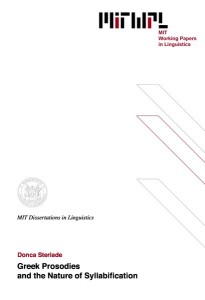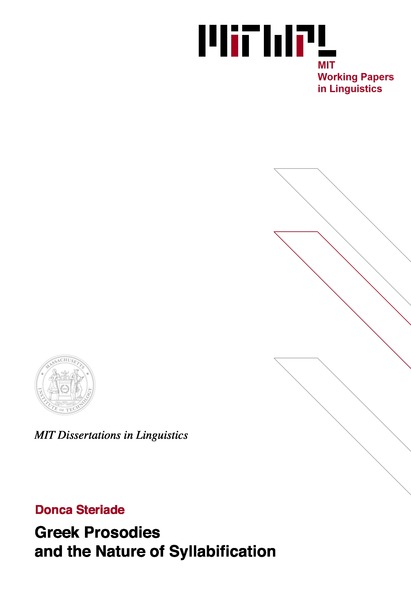Greek Prosodies and the Nature of Syllabification
D. Steriade, 1982


Save $4.95 (9%) if bought together with The Perceptual Basis of Long-Distance Laryngeal Restrictions
This thesis presents an autosegmental approach to certain prosodic phenomena of Ancient Greek: vowel length, geminate structures, aspiration, syllabic assignments. The Greek material – supplemented by Sanskrit and Latin – is used to develop a framework for the description of syllabification processes.
I claim that phonological strings are syllabified by a sequence of syllabic incorporation rules: a universal rule pairing of CV sequences into core CV syllables, followed by language-specific rules that incorporate into these syllables more of the neighboring segments. I claim that complex onsets and branching rimes are created by such languaeg-specific syllable adjunction rules.
I show that differences among the syllable structures of Latin, Greek and Sanskrit can be described as having two sources: different ordering relations among the syllable adjunction rules and different conditions on the relative sonority of adjacent tautosyllabic consonants. The latter parameter turns out to predict both the differences between the constraints on clustering in Greek and Sanskrit and the number of consonants each of these languages allows in the onset.
The relatively complex syllable structure of Greek is shown to require no reference to syllabic constituents other than onset and rime. The possible evidence for syllabic nodes other than onset and rime is shown in fact to be evidence for intermediate partially syllabified strings containing unaffiliated segments.
Thesis supervisor: Morris Halle
Title: Institue Professor
Table of Contents
Introduction 8
Chapter I The framework 13
1 Tiers of representation 13
1.1 Introduction 13
1.2 Skeleton/core relations 14
1.2.1 Contour segments 17
1.2.2 Geminates 27
1.3 Linked matrices 41
1.3.1 The autosegmental theory of assimilation rules 41
1.3.2 Geminates in the output of partial assimilation rules 47
1.3.3 Partially assimilation clusters and constraints on
geminates 52
1.3.4 The need for a Shared Features convention 67
2 Melody – Skeletion – Syllable mapping 70
3 Syllable structure and syllabification 72
3.1 Onsets and rimes 72
3.2 Syllabic parsing 74
3.2.1
3.2.2 A proposal 78
3.2.3 Core syllable rules and stray segments 84
3.2.4 Ordering constraints 86
3.3 Exhaustive syllabification and stray erasure 89
3.4 The sonority hierarchy 91
4 Lexical phonology 100
Footnotes 102
Chapter II Compensatory Lengthening and Resyllabification Types in Greek 113
1 Introduction 113
2 Compensatory lengthening and the empty node convention 114
3.1 Loss of w in Ancient Greek 117
3.2 The formal statement of CL and of resyllabification 125
3.2.1 The interaction of resyllabification and CL 126
3.2.2 CL, degemination and resyllabification 134
3.2.2.1 Degemination 136
3.2.2.2 Why degemination does not trigger CL in
Greek 139
3.2.2.3 Formulating CL without a skeleton 142
4 CL after s-deletion 146
4.1 The analysis 146
4.2 Sonorant-h metathesis 149
4.3 The autosegment h 154
5 Conclusion 163
Footnotes 168
Chapter III Attic Syllable Structure
1 Introduction 175
2 Evidence for syllabification in Attic 176
3 Syllabic divisions in the Attic prosody 186
4 Reduplication 195
5 Syllable structure and cluster simplification 209
5.1 Introduction 209
5.2 Possible clusters and their distribution 210
5.3.1 Cluster simplification 216
5.3.2 The minimal sonority difference in Attic 218
5.4 The segmental linking condition 223
5.5 Underlying clusters and segmental linking rules 230
5.5.1 Laryngeal feature assimilation 230
5.5.2 The grammar of aspiration in Attic 233
5.5.2.1 Grassmann’s Law 234
5.5.2.2 Aspiration assimilation and Bartholamae’s
Law in Greek 237
5.5.2.3 239
5.5.3 Coronal clusters 249
5.5.4 Labial clusters 252
5.5.5 Y-clusters in Attic 261
5.6 Excursus: the heterosyllabicity condition 272
5.7 Back to the segmental linking condition 278
6 The order of syllabification operations 285
Footnotes 293
Chapter IV The Structure of Heterosyllabic Initials
1 Introduction 301
2 Heterosyllabic initials in 1st millenium Greek 304
2.1 Reduplication 304
2.2 Loss of interconsonantal s, resyllabification and
reduplication 308
3 Heterosyllabic initials in Sanskrit 312
3.1 Reduplication 312
3.2 Loss of interconsontal s 328
4 Heterosyllabic initials in 2nd millenium Greek 333
4.1 Mycenaean spelling conventions 333
4.2 The s – h rule in common Greek 340
4.3 Archaic reduplications 350
5 353
6 Syllabification across major boundaries 355
7 Clusters across major boundaries, adjunction rules and the stray
erasure convention 361
Footnotes 373

